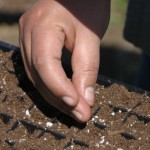 From Seed to Delivery – a pictorial essay
From Seed to Delivery – a pictorial essay
Here’s a pictorial essay of the journey the veggies in your box take from seed to delivery.
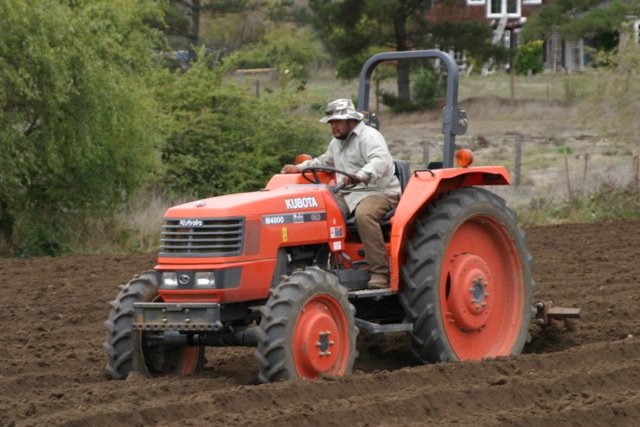
First the field has to be prepared and the beds formed.

Next comes setting the pipes and sprinklers for irrigating the crop.

Seeds are planted in trays and sprouted in our greenhouse.

Once the seeds have sprouted and become seedlings, they are transplanted to the field.
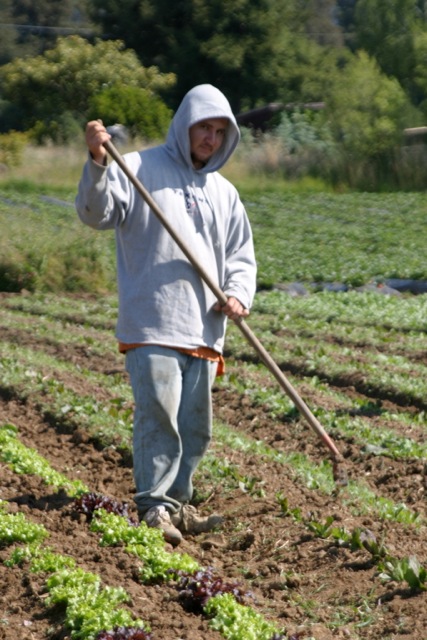
Weeding among the rows is necessary for the crops to thrive.

The veggies won’t grow without water. Here is a field of carrots getting sprinkled.

Harvesting of the crops is done by hand.
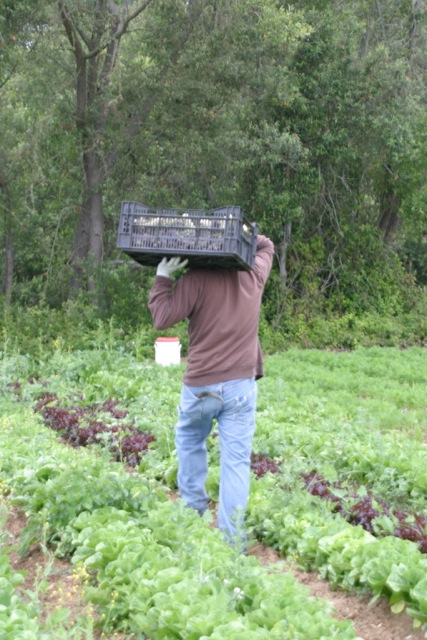
A crate of veggies going to get washed and packed.
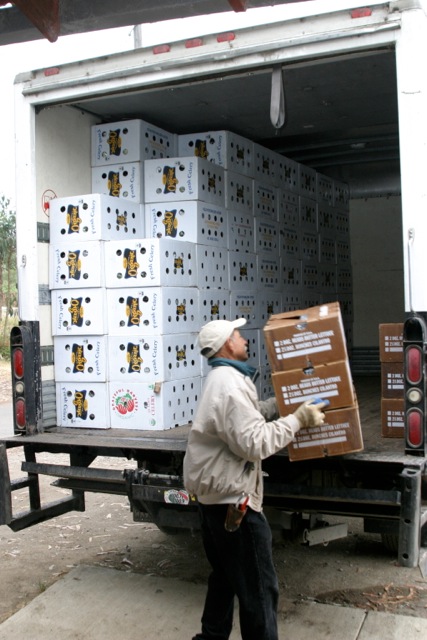
Once packed, the boxes go on the truck for delivery.
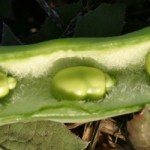 Fava Beans – a short-lived spring crop
Fava Beans – a short-lived spring crop
The “bell bean” favas you’ve heard me mention when I talk about our winter cover crop are not the edible kind, however their close cousins, the commonly known “broad beans” are. They are much larger, fat and oval. The edible Fava beans are a kind of shell bean, not as well known in America like they are among people living in Mediterranean countries. In Italy, when favas are in season, the Romans are known to go on countryside picnics where they feast on raw fava beans with cold white wine. The beans are spread out on newspaper, shelled, and sprinkled with Romano cheese.
One of the more tedious aspects of preparing fava beans has always been shelling and peeling them. The naked little beans are worth the trouble, but you still wind up throwing out about two thirds of what you started out with. Elisa was excited to help me with the shelling for dinner. I like to eat them with their skins, but if you like to peal them the skin slips off easily once they have been steamed or slightly boiled (1 min). Enjoy!

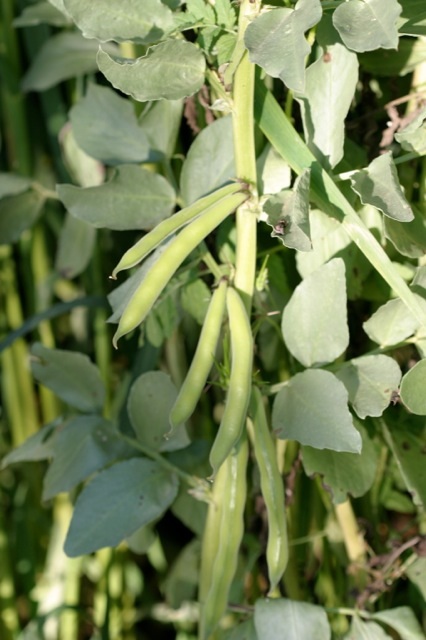
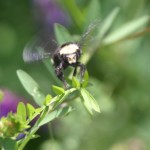 Bees are Buzzing on the Farm
Bees are Buzzing on the Farm
“If the bee disappeared off the face of the earth, man would only have four years left to live.”
-Albert Einstein

No lack of bees here on the farm. The buzzing is all around us, the air is filled with a low, continuous, almost eerie hum. It’s hard to pinpoint where the bees are working and the buzz is coming from exactly. Now that the apples and wild mustards are past their peak blooming period, the bees have moved into the “wilder” oak, redwood, and native chaparral environments of the farm.
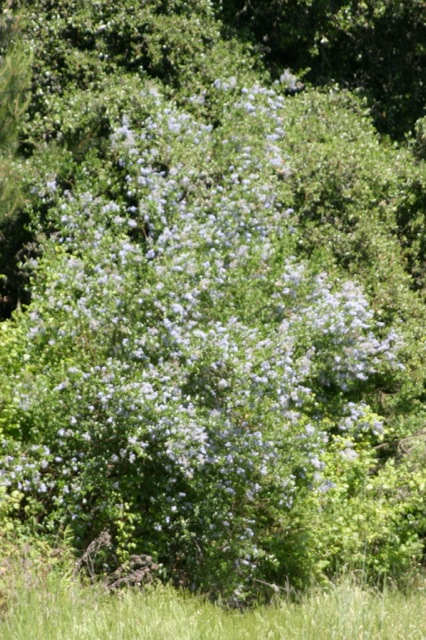
I recognize California Lilac with their beautiful blue flowers as well as sage, buckwheat, coffeeberry, penstimons and sticky monkeyflowers all blooming, but the humming upon closer inspection is coming from the poison oak growing green and lush everywhere.

I notice that the poison oak is packed with tiny, hardly noticeable whitish flower clusters. The bees are all in a hurry, climbing in and around these clusters, collecting their loads of nectar and pollen and then quickly getting it back to their hives to feed their brood (baby bees).
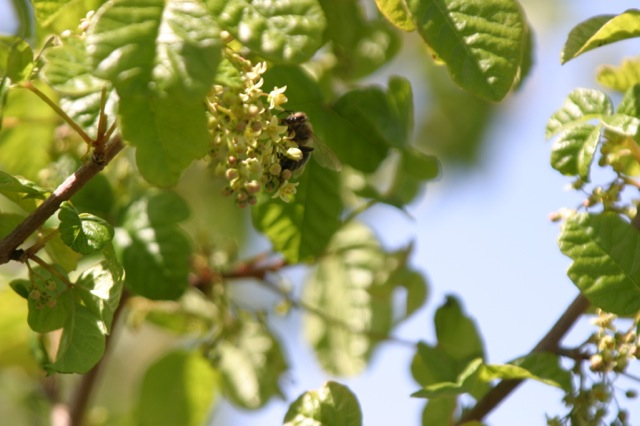
Anselmo Rivas, who keeps some of his hives here on the farm, explained that now is a good time to encourage honey production and increase the number of his working hives. When food is abundant the bee colony will increase in size, often to a point where it decides to split and swarm by following the queen and abandoning their present home to a new queen. Anselmo, like most beekeepers, is happy to capture a swarm; it’s like a present when Mother Nature gives you a complete working hive.
A few years ago I was walking past a row of willow trees near the apricot orchard when an intense buzzing sound caught my attention. I noticed that a swarm was hanging off a willow tree branch and I immediately called Anselmo.
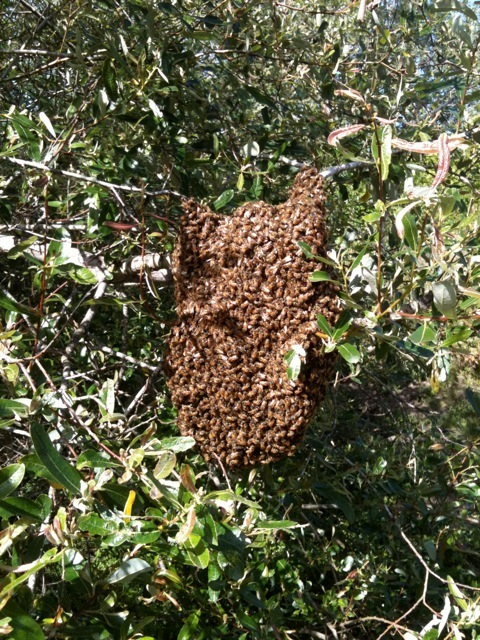
It took him less than ½ hour to show up with an empty box complete with frames fitted with wax foundations. He slid the box underneath the branch the bees where hanging from and started shaking it until a clump of bees, the one that had the queen in it, landed on the frames. Like a chaotic cyclone the rest of the bees immediately descended upon the box and slowly crawled into it – making Anselmo a very happy beekeeper!
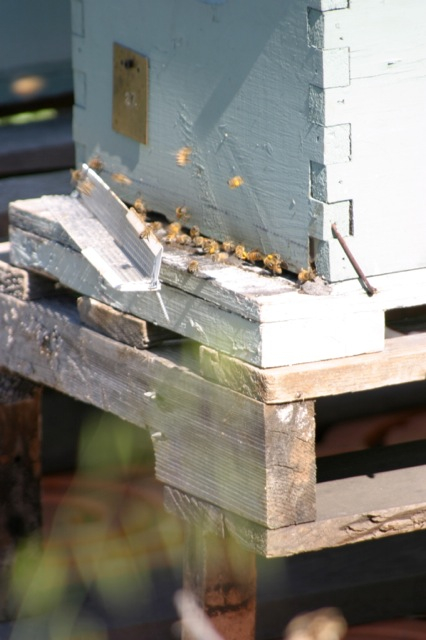
The honeybee is truly one of nature’s workhorses. What makes them so popular, besides the honey they share with us, is that they are able to pollinate a large number of different plant types. Due to their social nature, they tend to recruit other bees to visit the same plant several times during its blooming period, increasing the chances of pollination, thus resulting in higher yields of fruit or seeds. Imagine what the content of our shares would look like if pollination disappears. No strawberries, raspberries, blackberries, apples, pears, plums, apricots or cherries. No cucumbers, melons, winter or summer squashes.

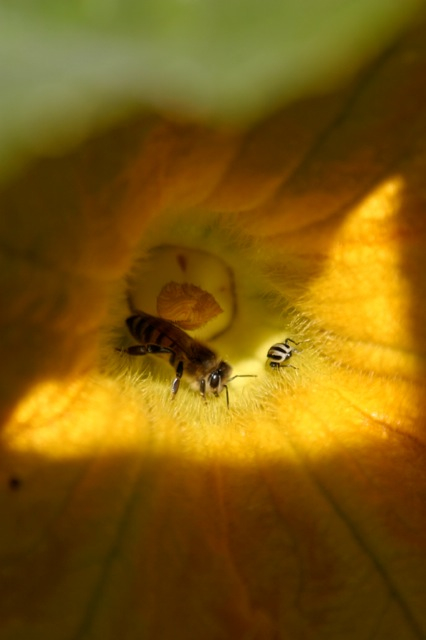
According to the Xerces Society, one in three mouthfuls of food and drink require the presence of a pollinator. Beekeepers have been struggling to maintain their bee population. Anselmo lost almost half of his hives last winter. He blames the decline to the destructive varroa mite and the overall lack of habitat around agricultural and urban landscapes to support honeybees and other pollinators such as bumble bees, butterflies, wasps, and native bees.
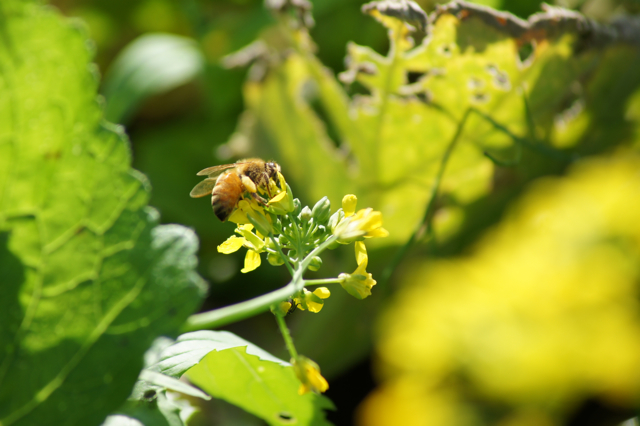
Here on the farm we have planted hedgerows, grow sunflower hedges, summer cover crops such as annual buckwheat, or decide to let crops such as broccoli, kale, or any of the brassicas (mustards) go to flower for the bees to feed on before plowing them back into the soil.

The best way to encourage and maintain the presence of pollinators is to preserve more wild land (habitat), set aside uncultivated areas (undisturbed hedgerows and field borders) and grow suitable crops to attract and increase their numbers, making sure to provide sufficient flowering/pollen producing plants to ‘feed’ them year round.
With Earth Day just around the corner, we can all decide to take a few steps to increase pollinator habitat whether it’s in your own backyard, office campus, community gardens, parks, you name it, any place free of pesticides where plants can grow, will serve as habitat for pollinators to forage, nest, lay eggs and multiply. A patch of flowers is fun to have around and observe as butterflies, bees, beetles, birds, moths and other interesting animals will start being attracted to it. With a healthier and more abundant population of pollinators we contribute to a healthier ecosystem around us.
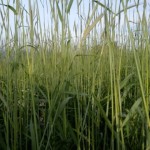 Cover Crops, not just for the soil!
Cover Crops, not just for the soil!
“We need to actively participate in our food system — in our political system — to make sure that the best food we can produce in this country is available to the most vulnerable eaters – our kids.” – Anonymous
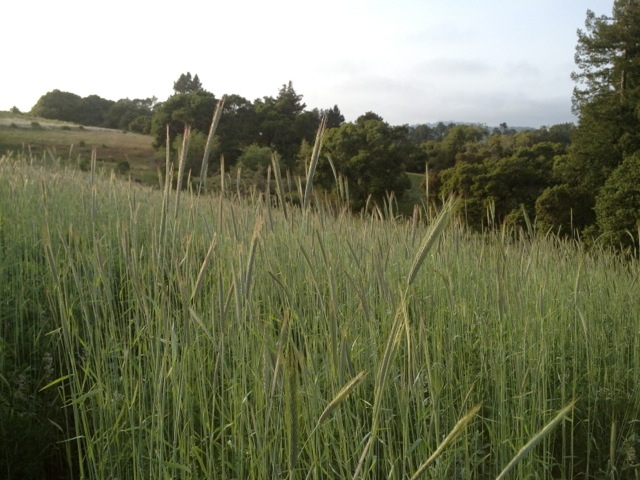
Elisa and I took last Saturday afternoon off to enjoy a father-daughter moment on the farm – just the two of us. First we had to visit “Granny,” one of our female goats who just 2 days prior birthed triplets. All three kids are healthy, taking turns suckling, and “mom” is patient enough to let them be held and cuddled.
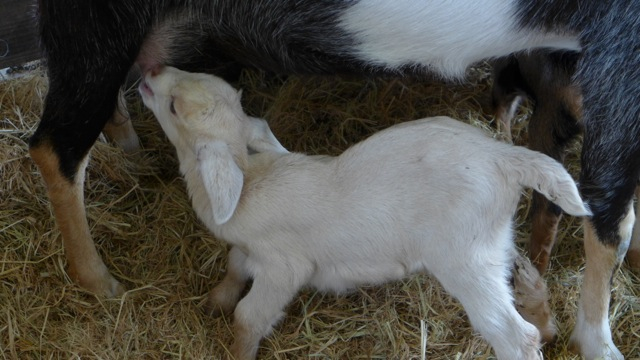
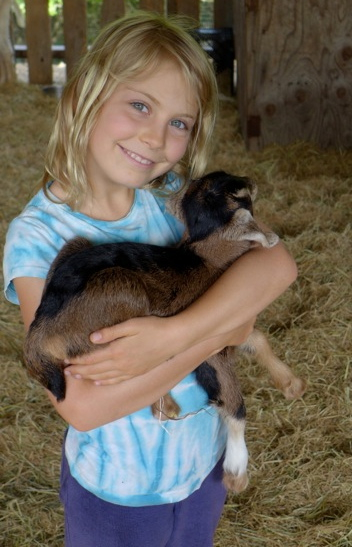
After getting our fill of playing with the goats we decided to pack a snack and go picnic by the pond on the upper portion of the farm. It is one of our favorite “get-away” spots with views over the Pajaro Valley and Santa Cruz mountains. The pond is surrounded by 4 acres of sloping fields, and I purposefully leave the cover crops to grow until the last major rains of the season are over. Right now the lush green cover stands almost 6 feet tall. Still untouched, it looks like an immense impenetrable jungle to 8-year-old Elisa


In no time at all, she and I turn into explorers crawling through a thicket of fava beans, vetch, peas and merced rye making secret passageways and dens, hiding from each other and letting our imagination run freely.
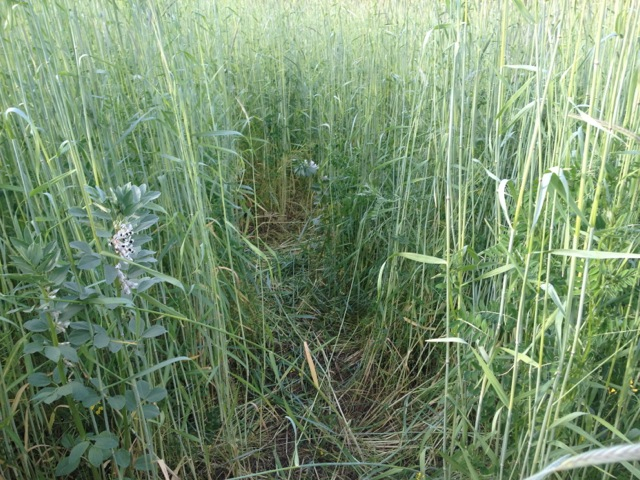
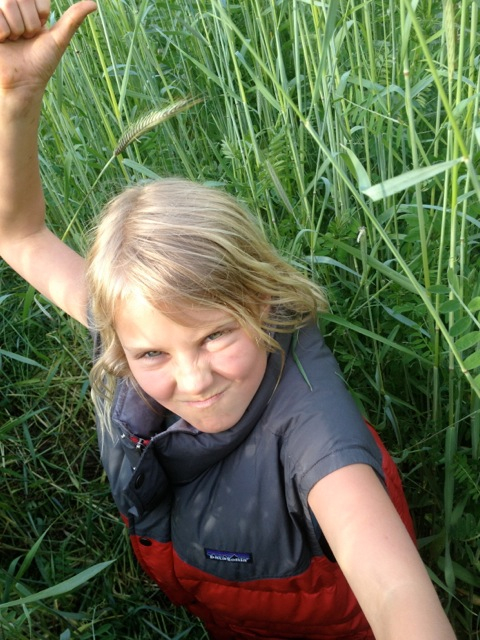
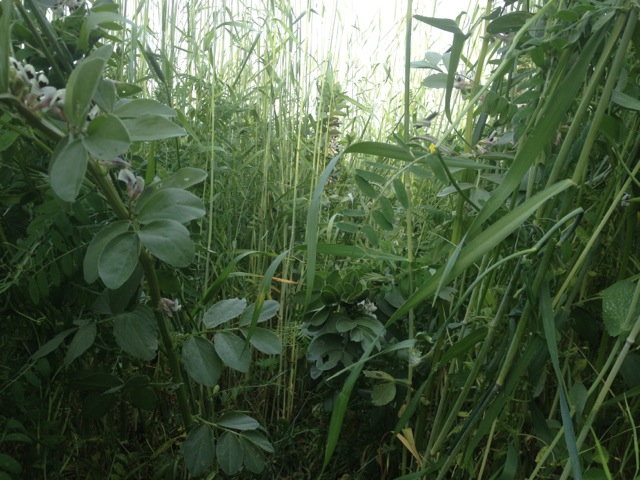
After what seems like “ages”, we finally emerge from the field to catch our breath. Elisa of course, whose world is all about games, wonders if I could leave the cover crop until later in the season so that she can invite her friends to play in it. While I explain the benefits of a cover crop – i.e. soil fertility, organic matter, higher crop yields – I feel the regret of having to plow this “magic” world back into the soil. I guess it’s a lesson of following the lifecycles of nature and understanding that, ultimately, a healthy soil allows us to continue growing more “magic” moments. Whether it’s a pumpkin patch, a tall corn maze, or more cover crops – the possibilities are endlessly nourishing.
To wrap up the afternoon we swing by the strawberry patch and I see how one field’s “magic” is quickly replaced by another, as Elisa picks and bites into a large sweet berry. We know the season has started when the strawberry harvest picks up. Every share will get a basket this week!
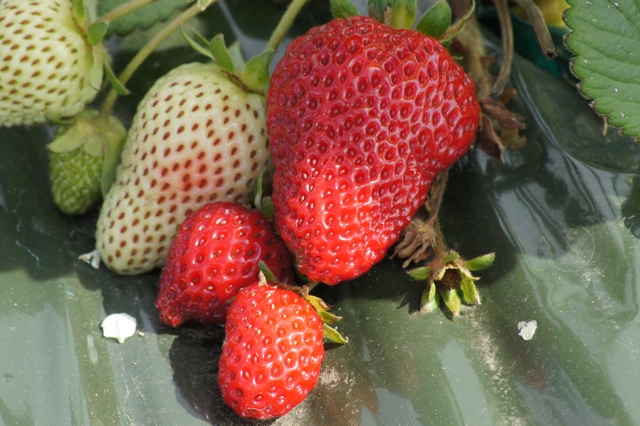
As the last of the winter cover crop is being mowed the soil is prepared and ready to be planted with summer crops. The first batch of dry-farmed tomato seedlings got planted last week, and this week sun gold cherry tomatoes and peppers will follow. With the soil now warm enough, we will also sow the first of several successions of green beans. So hold on, the bounty of summer is upon us before we know it!!!
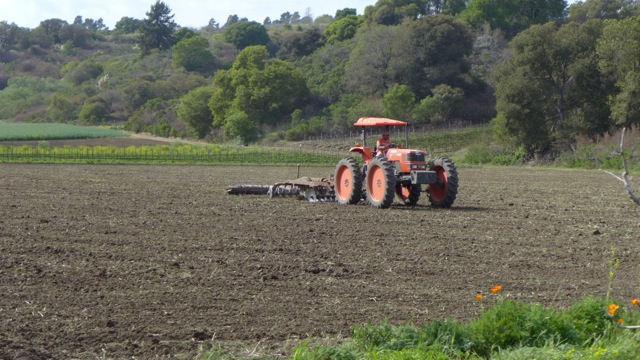
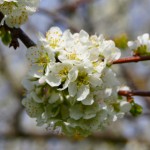 A Great Start to a Promising Fruit Season
A Great Start to a Promising Fruit Season
This is the year you want to be a CSA member and signed up with an Extra Fruit Option.

The dry and warm early spring weather promises for a bountiful fruit harvest. The bare limned orchards burst into bloom a few weeks ago, first the apricots and plums followed by pears, quince and apples. Strawberries are ripening, and we started picking a few last week. Their quantity will steadily increase, and by June I wouldn’t be surprised if you will be freezing and jamming them. By the end of June, strawberries will be complimented by Santa Rosa and Satsuma Plums just as raspberries and blackberries are starting to come into production.

The brief appearance of our Royal Blenheims in July will overshadow everything else given their short season and irresistible and wonderful flavor. Our 3-acre orchard, which the last two years has not yielded much due to wet spring weather, burst into bloom and thanks to favorable conditions this year has a great fruit-set.

Amidst an abundance of raspberries and blackberries in July and August, our popular sungold cherry tomatoes and dry-farmed tomatoes will be ready for picking as well. By late August early September the delicious Galas and Warren Pears will announce the coming of Fall.

As strawberries typically have a second flush in early September, apples, grapes and pineapple guavas will be plentiful to round out the end of the season. I anticipate the farm will host a lot of u-picks for our community to enjoy. This may be a good year to be a CSA member and to sign up for an extra fruit option. So order extra canning jars and set aside enough time to preserve the many flavorful fruits and vegetables we are growing.
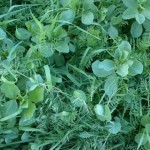 In the Field – Cover Crops
In the Field – Cover Crops
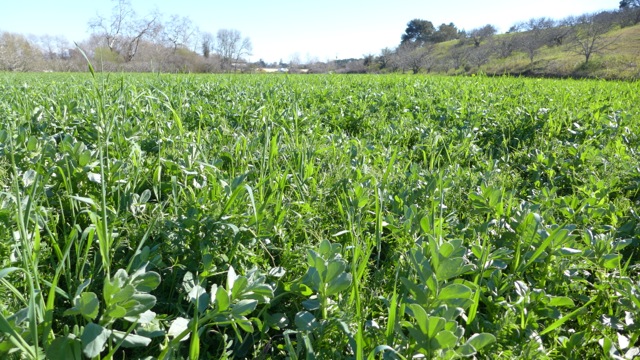 The winter cover crops in our fields look like beautiful lush green carpets. They are important to improve our soils by building organic matter, suppressing weeds, resurface and supply plant nutrients to our crops, reduce erosion and improve water quality. In a few weeks they will be mowed and tilled back into the earth.
The winter cover crops in our fields look like beautiful lush green carpets. They are important to improve our soils by building organic matter, suppressing weeds, resurface and supply plant nutrients to our crops, reduce erosion and improve water quality. In a few weeks they will be mowed and tilled back into the earth.
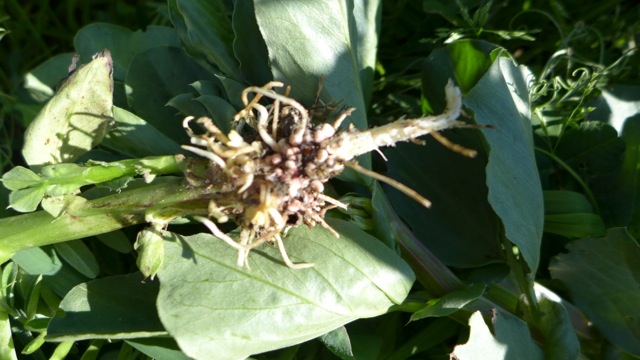 Our cover crop is made up of rye (cereal) and a mix of several legumes (nitrogen fixers) bell beans, vetch, and peas. The pink nodules on the roots of the bell beans are characteristic of legumes, it’s where bacteria fix nitrogen, which later are released into the soil to serve as nutrients for our crops.
Our cover crop is made up of rye (cereal) and a mix of several legumes (nitrogen fixers) bell beans, vetch, and peas. The pink nodules on the roots of the bell beans are characteristic of legumes, it’s where bacteria fix nitrogen, which later are released into the soil to serve as nutrients for our crops.

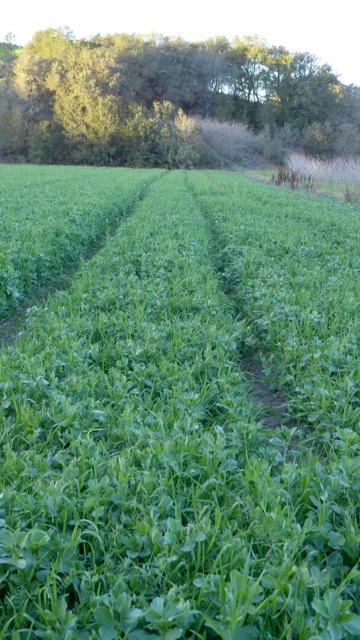
 Leaps of Faith and Dreaming of Harvesting Potatoes
Leaps of Faith and Dreaming of Harvesting Potatoes
“To plant a seed and believe that it will germinate, out-compete weeds, bloom, set fruit, and be harvested and sold at a fair price is a great leap of faith.”
– Organic farming pioneers, Denesse Willey of T&D Willey Farms in Fresno,CA
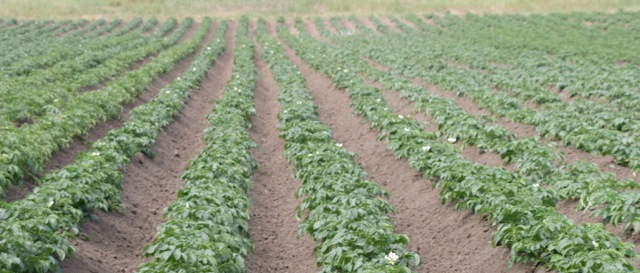
For some it may be a trivial matter but for farmers and gardeners here in the northern hemisphere Spring is around the corner. Our seed orders are arriving and we are once again committed to engage in the seasonal ritual of planting and sowing, taking that great leap of faith that these seeds, these tiny treasures of nature, will germinate, compete and succeed to yield an abundant nourishing harvest. Of all the seeds we plant, among my favorite ones are the potatoes.
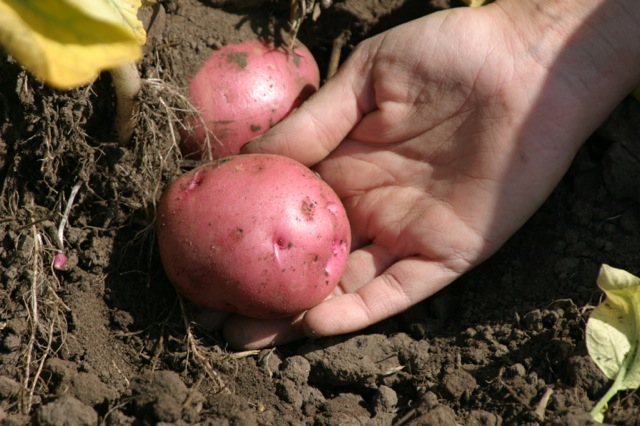
Our seed potatoes arrived last week, stacked on a wooden pallet, shipped directly from a seed farm (Rockey Farms) in Colorado via a semi-truck making deliveries to organic farmers up and down the Central Coast. Unlike most of our other seeds which arrive in the mail, a few pounds at a time, we have to order a few thousand pounds of certified potato seed to plant out 2 – 3 acres.
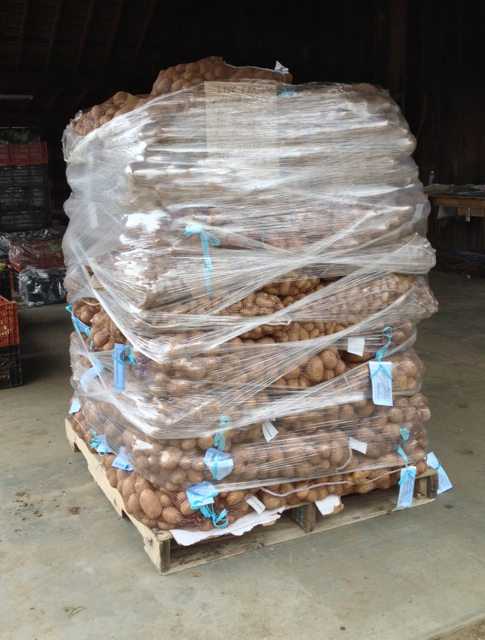
Although potatoes grow underground they are not really roots. They are the swollen ends of skinny underground stems also known as tubers. The potato tubers have nodes or eyes from which the new growth begins. The new stems growing from each eye are called sprouts. Sprouts grow from the tuber after a period of dormancy.
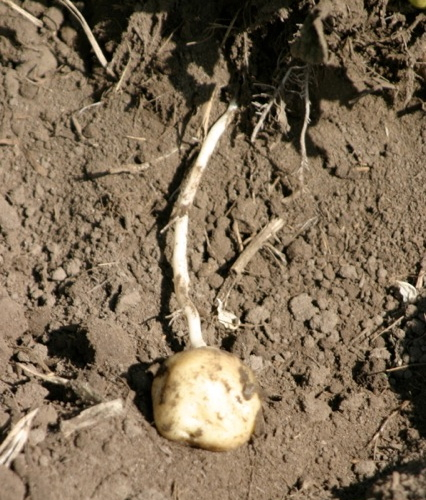
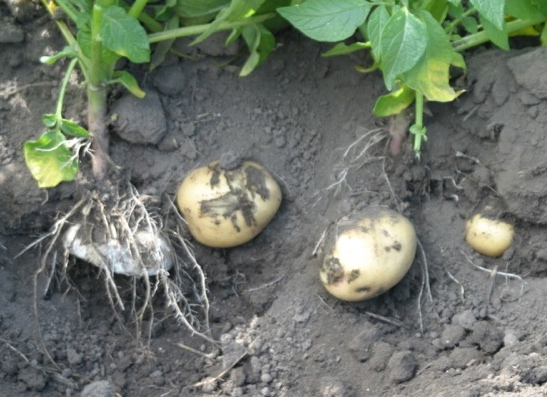
Since we are almost ready to plant, we encourage the seed potatoes we received last week to break their dormancy so that sprouts will grow when they get planted. These sprouts give rise to the plant stems, and in order to stimulate the formation of new tubers about a quarter to a third of the plant has to be covered with soil, also known as ‘hilling up”. Under favorable growing conditions, 1 pound of planted seed potatoes will yield about 10 pounds of harvestable potatoes.

Potatoes are adapted to grow in many different climates throughout the world. From their place of origin in the Andes mountains of South America all the way to much warmer coastal areas such as exist on islands of the South Pacific. Although potatoes grow better in cooler climates, during my years as a Peace Corps volunteer (1985-87) I worked with farmers on the island nation of Western Samoa who successfully grew selected varieties adapted to their more tropical farming conditions. Here along the Central Coast, not too long ago, farmers used to grow potatoes in larger quantities before the more lucrative berries took over.
We’ll be growing 5 different varieties this year. German Butterballs, a round to oblong tuber with lightly netted skin with deep yellow flesh. Slightly mealy, this variety is superb for everything – frying, baking, mashing, soups – you name it. Russian Bananas, probably best known of the fingerlings, are the only ones of this type we’ll be growing this year. It matures early and I love them steamed or roasted. Carola, with a beautiful yellow color has a creamy texture and exquisite flavor – great steamed, boiled, baked, or fried. Desiree, has oval tubers with beautiful rosy skin and creamy yellow flesh. Excellent for salads, boiling, or mashing. Finally our traditional Yellow Finn with it’s dark yellow flesh is moist with a little mealiness, excellent for baking, mashing, or frying.
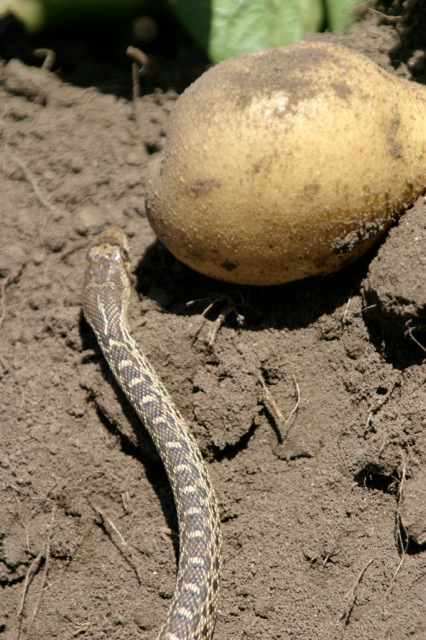
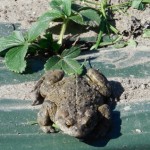 I Feel the Earth Stirring with Life
I Feel the Earth Stirring with Life
Once again mother nature is stirring to commence another seasonal cycle of life. The strawberry plants are starting to sprout new leaves and flower buds, signaling that the winter energy stored in the soil is starting to push up to the surface. Right now is a good time to remove any weeds growing in the furrows or poking through the mulch, competing with the growing plants.
 To ensure a healthy crop and an early harvest when spring arrives we have to establish a healthy population of beneficial red spider mites, also known as Persimmillis. Now is the time we release them in the tens of thousands in order to control and prevent any future outbreak of another mite, this one known as the two-spotted-spider mite, which if left un-checked can cause serious leaf damage and loss in both yield and quality.
To ensure a healthy crop and an early harvest when spring arrives we have to establish a healthy population of beneficial red spider mites, also known as Persimmillis. Now is the time we release them in the tens of thousands in order to control and prevent any future outbreak of another mite, this one known as the two-spotted-spider mite, which if left un-checked can cause serious leaf damage and loss in both yield and quality.
 Growing strawberries organically has many challenges. Every part of the plant, from its root tips to its leaves and berries, is vulnerable to being eaten or damaged by something. It’s a formidable odyssey for an organic strawberry to end up in your hand unblemished.
Growing strawberries organically has many challenges. Every part of the plant, from its root tips to its leaves and berries, is vulnerable to being eaten or damaged by something. It’s a formidable odyssey for an organic strawberry to end up in your hand unblemished.
 We grow two different varieties: Seascape and Albion. Much about the qualities of a strawberry variety is determined by its genetic make-up and the result of decades, if not centuries, of careful selection and breeding. Over the course of the season you will likely receive berries from each variety, and have the opportunity to experience their differences in flavor, shape, texture, and storability. Some have an early start, others spread their production over the entire season; some are firm, others are juicier and softer; and for us, the farmers, we like to see that they are resistant to pests and diseases and vigorous under different soil and climate conditions. Not all aspects of strawberries are determined by genetics, especially when it comes to what is ultimately most important to us… flavor and taste. The subtleties of coaxing the best flavor out of a particular fruit or vegetable has a lot to do with a farm’s specific soil and weather conditions, and each farmer’s specific growing practices focused on enhancing flavor rather than yield. I’ll share more on those growing practices once we are starting to enjoy these red jewels. My favorite way to enjoy them is to pick them straight from the plant, red-ripe and sun-warmed. Don’t forget to Sign Up! 🙂
We grow two different varieties: Seascape and Albion. Much about the qualities of a strawberry variety is determined by its genetic make-up and the result of decades, if not centuries, of careful selection and breeding. Over the course of the season you will likely receive berries from each variety, and have the opportunity to experience their differences in flavor, shape, texture, and storability. Some have an early start, others spread their production over the entire season; some are firm, others are juicier and softer; and for us, the farmers, we like to see that they are resistant to pests and diseases and vigorous under different soil and climate conditions. Not all aspects of strawberries are determined by genetics, especially when it comes to what is ultimately most important to us… flavor and taste. The subtleties of coaxing the best flavor out of a particular fruit or vegetable has a lot to do with a farm’s specific soil and weather conditions, and each farmer’s specific growing practices focused on enhancing flavor rather than yield. I’ll share more on those growing practices once we are starting to enjoy these red jewels. My favorite way to enjoy them is to pick them straight from the plant, red-ripe and sun-warmed. Don’t forget to Sign Up! 🙂
Only two short months from now, we’ll all be smiling!!!
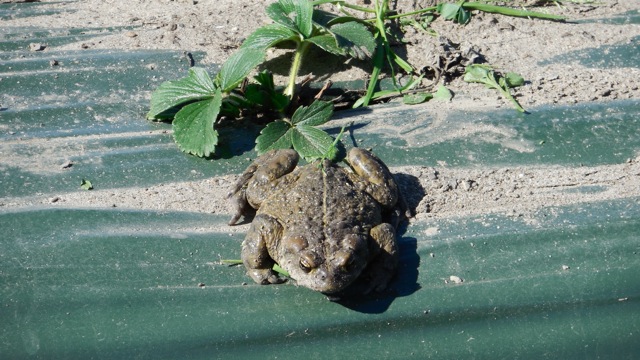
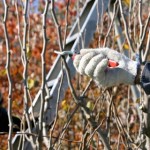 Pruning: Having a conversation with the trees
Pruning: Having a conversation with the trees
Farmer Tom here – one of my favorite things to do during the winter months is pruning our apple orchards. Pruning is an important activity which I view as a conversation of sorts, where the main objective of every cut is about the long term well-being of the trees. You only get one opportunity at pruning every year, and with every tree one needs to take a short pause to understand what kind of pruning cuts to make to assure a bountiful production not just for the current but also subsequent years.

A tree responds to different cuts in different ways. Some cuts are thinning cuts typically made at the juncture of two branches and are meant to remove a branch that is no longer desirable, either due to excessive crowding or it may be dead or unhealthy. There are also what are known as heading cuts, made across a branch, out from the branch union typically these cuts help to shape a tree, manage its vegetative vigor and maximize its fruiting potential.


A guiding principle of why we prune every year is to maximize sunlight throughout the tree’s canopy to achieve a desirable quality and quantity of fruit. I have only been growing apples for about 10 years, and consider myself very much a novice. I have been lucky that some very experienced growers have given me valuable advice, and I am always grateful to learn as much as I can from them every year. Especially when it comes to working with young trees not fully shaped, each one is unique and it is an art to visualize how a tree will mature, make the kind of strategic pruning cuts that ensure it will be healthy, productive and manageable so that the entire orchard in turn can offer us many bountiful years into the future. For an experienced grower it will almost be intuitive what cuts to make, while I still proceed slowly, often hesitating, asking questions. But as one multi-generational apple grower once said encouragingly: “I never expect to master the art of pruning, there is always more to learn”.
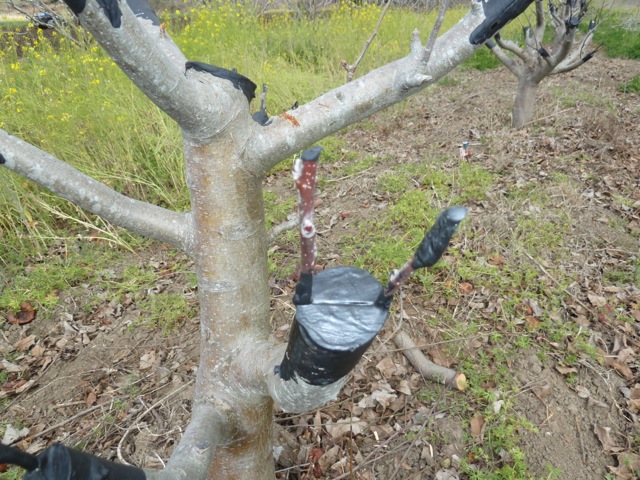
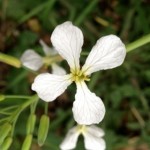 Crop & Field Notes: One of my favorite ‘Crucifers’!!??
Crop & Field Notes: One of my favorite ‘Crucifers’!!??
Many of the vegetable varieties that grow well here on the farm during the winter season belong to the Mustard family. Although each variety will vary in appearance, you can always tell from their cross-shaped flowers that they are related, hence another common family name they are known by is Crucifers or Brassicas. The more popular Crucifers we grow are Broccoli, Cabbage, Kale, Collards, Radishes, Bok Choi, Napa Cabbage, Arugula, Turnips, Asian Greens such as Mizuna and Tatsoi, and right now the most abundant, Brussels sprouts (Brassica Oleracea gemmifera) – one of my favorite. Like their cousins, they have adapted to subfreezing temperatures by converting starch into sugars, allowing them to lower the freezing point of their sap, preventing the cells from rupturing and damaging the plants tissue. So with the frosty temperatures we had a couple of weeks ago, the Brussels sprouts have a distinct and subtle sweetness. If you grew up eating and hating Brussels sprouts that were picked too mature and boiled too long, give them another chance.

Brussels sprouts might look comical and unusual with their long stems covered in tiny mature cabbages but they take time, planning, patience, and commitment to grow. Even before we get to pick our first summer crop, we have to start planning where our brussels sprouts will grow and overwinter. They are started from seed in the greenhouse in late May, transplanted in July in hopes that we get to harvest them before Thanksgiving or at least by early December. From seed to first harvest, it can take over 150 days. Last year we got a late start, the early varieties were out of stock and the seedlings got transplanted in late July, therefore our harvest only got started towards the end of December.

Sprouts were believed to have been cultivated in Italy in Roman times, and possibly as early as the 1200s in Belgium. The modern Brussels sprout that we are familiar with was first cultivated in large quantities in Belgium (hence the name “Brussels” sprouts) as early as 1587, with their introduction into the U.S. in the 1800s. They were grown in California in the early 1900s, with the first central coast plantings in the 1920s. Production peaked in the 1960‘s, and today approximately 3000 acres in California are still in Brussels sprout production. This acreage supplies the majority of the U.S. production from June through January, with nearly all of the acreage located in the central coast region, in San Mateo, Santa Cruz, and Monterey counties.

